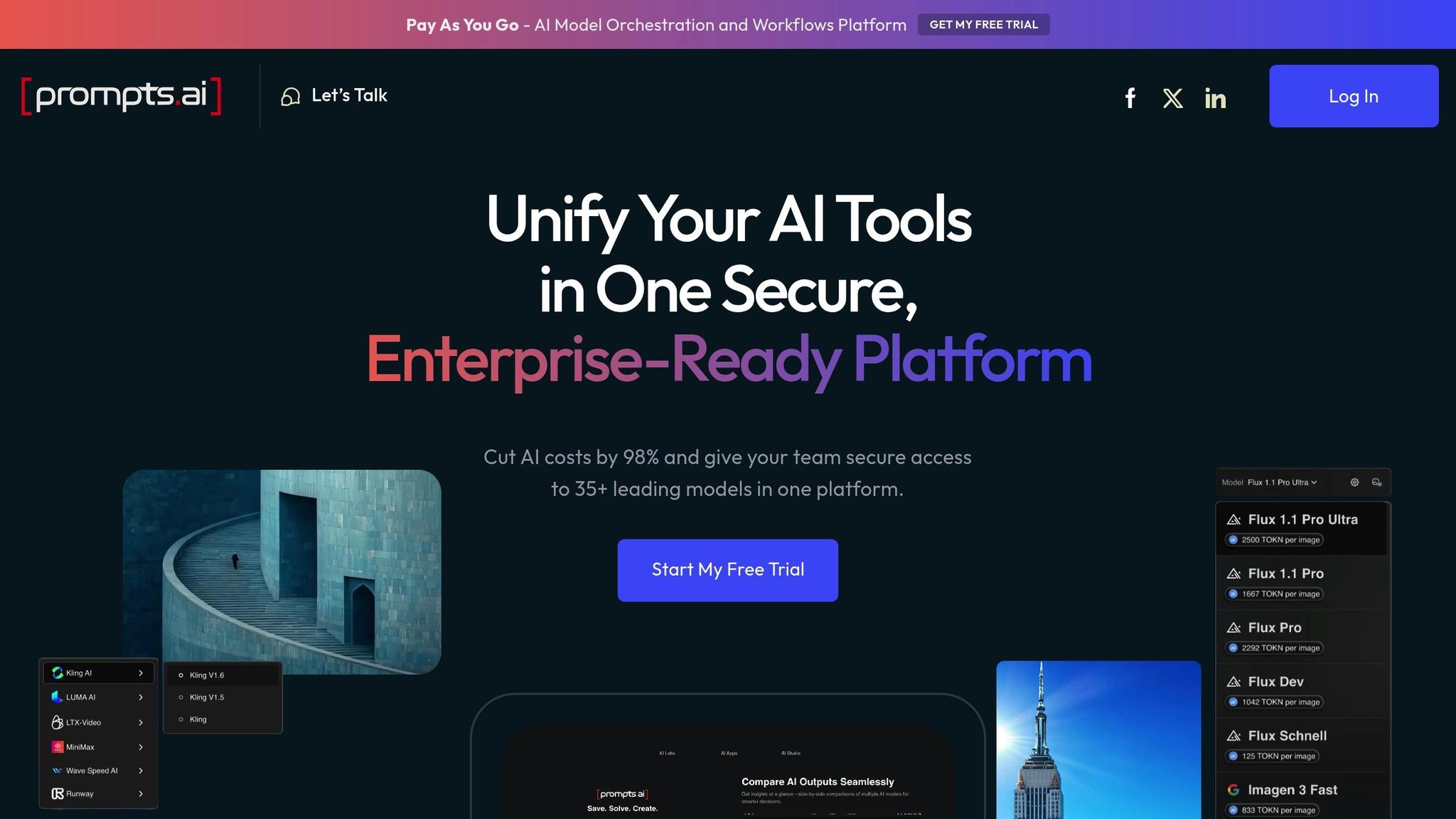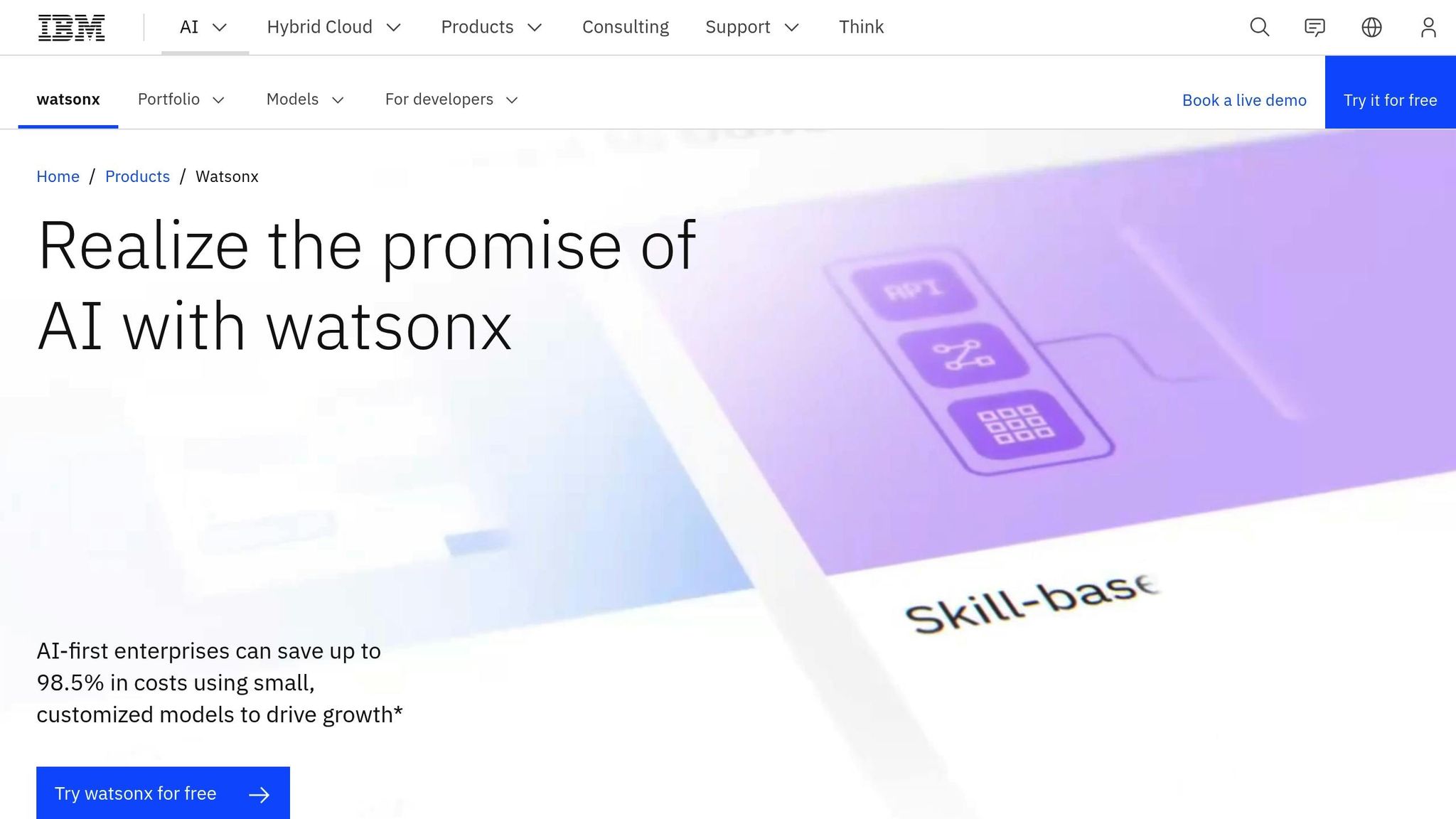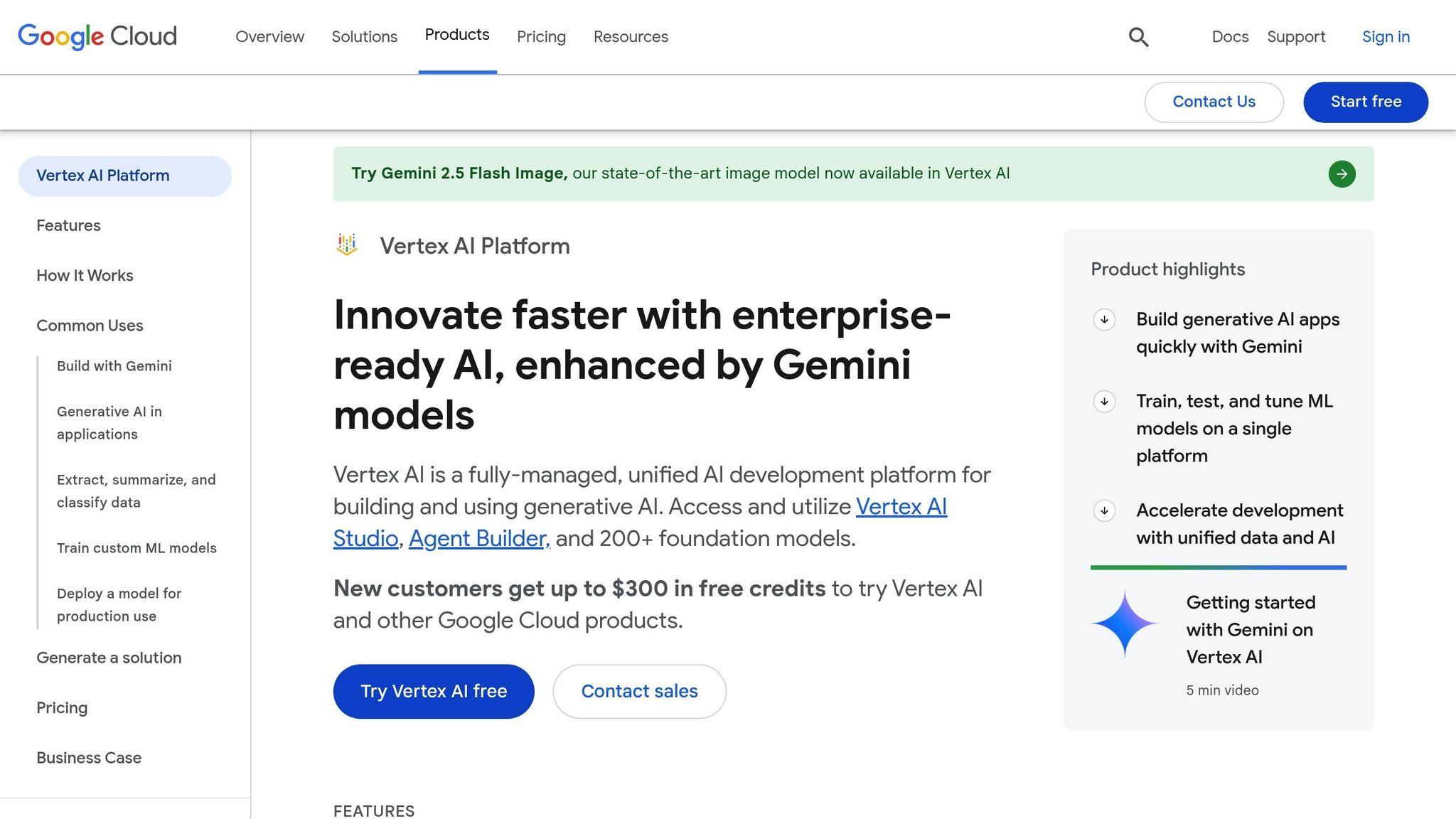
In today’s complex digital business environment, organizations need AI platforms that simplify operations, control costs, and ensure compliance. This article compares three leading platforms - Prompts.ai, IBM Watsonx, and Google Vertex AI - to help you choose the right solution for your business needs.
| Platform | Strengths | Limitations |
|---|---|---|
| Prompts.ai | Cost savings, 35+ AI models, real-time cost tracking | Limited to core orchestration features |
| IBM Watsonx | Governance, compliance, hybrid cloud integration | High costs, complex licensing |
| Google Vertex AI | Google Cloud tools, AutoML, preemptible savings | Dependency on Google, learning curve |
Conclusion:
Choose based on your priorities: cost control, integration, or compliance.

Prompts.ai is a powerful enterprise platform designed to bring together over 35 large language models (including GPT-5, Claude, LLaMA, and Gemini) into a single, secure interface. By simplifying access to these advanced tools, it helps businesses navigate the complexities of the digital economy. Here's how Prompts.ai tackles key challenges like interoperability, automation, governance, and cost management to streamline operations.
One of the standout features of Prompts.ai is its ability to integrate multiple AI models into a unified dashboard. This centralized system allows users to easily select models, manage prompts, compare performance, and switch between models without the hassle of rebuilding workflows or retraining teams. It eliminates the fragmentation often associated with using multiple AI tools.
Prompts.ai turns scattered experimentation into consistent, efficient workflows. It provides pre-built workflows based on industry best practices, enabling organizations to standardize their AI processes across departments. Teams can also automate sequences by linking multiple AI interactions, allowing complex business tasks to be executed with minimal manual input.
Prompts.ai prioritizes security and compliance, making it an ideal solution for enterprises in regulated sectors. The platform ensures that sensitive data stays within the organization during AI interactions. With features like audit trails, enterprise-grade controls, and customizable permission settings, it offers robust tools to monitor usage and maintain compliance.
Prompts.ai takes a transparent approach to cost management with its real-time FinOps controls. It tracks token usage across all models and directly ties spending to business outcomes. By using the Pay-As-You-Go TOKN credit system, organizations can cut AI software costs by up to 98%. This approach not only reduces expenses but also helps teams better predict and manage their AI budgets, ensuring a more efficient allocation of resources.

IBM Watsonx steps in as a powerful solution for businesses seeking integrated and secure AI platforms. Designed to cater to enterprise needs, it combines foundation models, generative AI, and machine learning to create a unified platform. While it shares similarities with Prompts.ai in terms of reliable AI orchestration, Watsonx places a stronger emphasis on system integration. Its primary goal is to help businesses develop, deploy, and scale AI applications while adhering to stringent governance requirements.
Watsonx employs a hybrid cloud architecture, ensuring seamless integration with existing enterprise systems. It connects effortlessly with widely used tools such as Salesforce, SAP, and Microsoft Office 365, allowing businesses to maintain their current workflows without disruption. For developers, Watsonx supports Python, R, and Scala, making it accessible to a broad range of users.
The platform's open architecture enables organizations to work with multiple data sources simultaneously, whether they are stored on-premises or in the cloud. This adaptability is especially useful for businesses with complex IT setups involving multiple vendors and technologies. By integrating these diverse systems, Watsonx simplifies operations and enhances decision-making processes. Once integrated, it further optimizes workflows through automation.
Watsonx includes AutoAI capabilities that streamline data preparation, algorithm selection, and model pipeline creation. With pre-built workflows tailored to various industries, businesses can accelerate the deployment of AI-driven processes, improving operational efficiency.
The Watson Studio component empowers teams to design automated workflows for tasks such as document processing, customer sentiment analysis, and extracting insights from unstructured data. These workflows can be triggered by specific events, like new customer inquiries or inventory updates, ensuring businesses can respond dynamically to real-time demands.
Governance is a cornerstone of Watsonx, with Watson OpenScale providing tools to monitor model bias, drift, and overall performance. Every AI decision is meticulously logged, creating detailed audit trails that meet compliance standards.
To safeguard data, Watsonx employs end-to-end encryption and role-based access controls, ensuring sensitive information remains protected. The platform also complies with major regulations, including GDPR, HIPAA, and SOX, through built-in privacy controls and data lineage tracking. These features ensure that Watsonx not only meets but often exceeds governance expectations for enterprise operations.
Watsonx offers a consumption-based pricing model, complemented by real-time dashboards that track expenses related to compute, storage, and training. This level of detail allows businesses to identify underutilized resources and adjust their capacity according to actual needs, ensuring efficient use of resources and smarter spending.

Google Vertex AI brings together Google's AI solutions on a single platform. Built on the foundation of Google Cloud's powerful infrastructure, it simplifies the machine learning lifecycle while delivering the scalability needed for enterprise applications. It is particularly well-suited for managing large-scale data processing and offers tools for building, deploying, and managing AI models with ease.
Vertex AI integrates effortlessly with the Google Cloud ecosystem, connecting seamlessly to tools like BigQuery for data warehousing, Cloud Storage for managing data, and Looker for business intelligence. These integrations streamline workflows and ensure businesses get the most out of their cloud investments.
The platform supports widely-used machine learning frameworks, including TensorFlow, PyTorch, and scikit-learn, giving developers the flexibility to use their preferred tools. It also provides APIs for connecting with external applications. By leveraging Google Kubernetes Engine, Vertex AI ensures consistent model deployment at every stage, from development to production.
Vertex AI Pipelines automates the entire machine learning process, from data ingestion to deploying models. Its AutoML capabilities handle tasks like feature engineering, hyperparameter tuning, and model selection, drastically cutting down the time needed to create functional models.
The Vertex AI Workbench provides a managed Jupyter notebook environment that automatically adjusts compute resources, allowing data scientists to focus on refining their models. Users can schedule custom training jobs and enable continuous monitoring with alerts for any performance issues, ensuring models remain effective over time.
Vertex AI benefits from Google Cloud's robust security measures, including Identity and Access Management (IAM) for granular control over permissions and VPC Service Controls for network-level security. All data is encrypted both in transit and at rest.
The platform includes tools for model explainability, helping businesses understand how their AI models make decisions - an essential feature for meeting regulatory requirements in industries like finance and healthcare. The Vertex AI Model Registry tracks versioning and lineage for all models, offering clear audit trails.
Real-time monitoring capabilities keep an eye on metrics like model bias, drift, and overall performance, with detailed logs to support compliance with regulations such as GDPR. These features ensure that businesses can operate within regulatory frameworks while maintaining trust in their AI systems.
Vertex AI uses a pay-as-you-go pricing model, charging based on actual compute time, storage, and API usage. Google Cloud's billing dashboard provides detailed cost breakdowns, allowing businesses to track expenses by project, team, or individual model.
For training workloads that can tolerate interruptions, preemptible instances offer up to 80% savings compared to standard instances. Automatic scaling ensures that resources are only used when necessary, avoiding over-provisioning and unnecessary costs.
The Google Cloud Console offers cost optimization recommendations, helping teams identify ways to save through better resource allocation. Configurable budget alerts notify users when spending approaches set limits, ensuring tight control over expenses. This comprehensive cost management system makes Vertex AI a strong option for businesses looking to balance performance with budget-conscious AI initiatives.
This section highlights the strengths and trade-offs of three key platforms - Prompts.ai, IBM Watsonx, and Google Vertex AI - focusing on cost, integration, and compliance. By understanding these differences, organizations can make informed decisions that align with their goals, budgets, and technical needs.
Prompts.ai stands out for its extensive model variety and precise cost management. With access to over 35 leading AI models through a single enterprise-grade interface, it offers flexibility and control. The pay-as-you-go TOKN credit system, combined with built-in FinOps tools, ensures detailed cost transparency, enabling businesses to monitor and refine spending at the workflow level.
IBM Watsonx capitalizes on IBM's deep experience in enterprise AI, offering advanced governance tools, detailed audit trails, and compliance solutions tailored to industries like healthcare and finance. Its hybrid cloud functionality adds flexibility, but the platform's pricing and licensing structures can be complex and costly.
Google Vertex AI leverages Google Cloud's infrastructure to provide seamless ecosystem integration. Features like AutoML and managed Jupyter notebook environments speed up development, while preemptible instances can cut training costs by as much as 80%. However, teams unfamiliar with Google Cloud may face a steep learning curve, and dependency on Google’s ecosystem could limit flexibility.
| Platform | Strengths | Limitations |
|---|---|---|
| Prompts.ai | 35+ AI models; Up to 98% cost savings; Real-time FinOps tracking | Limited to core orchestration with ongoing feature expansion |
| IBM Watsonx | Enterprise governance; Compliance tools; Hybrid cloud flexibility | High implementation costs; Complex licensing |
| Google Vertex AI | Google Cloud integration; AutoML automation; 80% savings with preemptible instances | Dependency on Google ecosystem; Learning curve |
Cost is a critical factor when comparing these platforms. IBM Watsonx offers extensive features but at a higher price point, making it more suitable for organizations with complex compliance needs. Prompts.ai and Google Vertex AI, on the other hand, provide more cost-effective options. Prompts.ai eliminates recurring fees and offers granular cost control, addressing the unpredictability of AI expenses. Google Vertex AI strikes a balance with competitive pricing but can become expensive with heavy usage.
Integration capabilities also vary. IBM Watsonx excels in integrating with enterprise systems, making it ideal for industries requiring robust compliance and governance. Google Vertex AI is tightly integrated within the Google ecosystem, streamlining workflows for those already using Google Cloud. Prompts.ai simplifies integration by focusing on centralized model orchestration, making it an efficient choice for automating workflows.
Governance approaches differ across platforms. IBM Watsonx leads with its mature audit trails and compliance-focused tools, catering to industries with strict regulatory requirements. Google Vertex AI benefits from Google Cloud's strong security framework, while Prompts.ai embeds transparent tracking into workflows, simplifying oversight and ensuring accountability.
Choosing the right platform requires balancing cost, integration, and governance needs. Each platform offers unique advantages, allowing organizations to tailor their AI strategies for efficiency and alignment with their goals.
When selecting an AI platform, it's essential to weigh factors like cost efficiency, adaptability, and governance needs. Here's a closer look at which platform aligns best with these priorities.
For those prioritizing cost management and flexibility, Prompts.ai is a standout choice. Its pay-as-you-go TOKN system, paired with an expansive model library, ensures tight control over expenses while offering unparalleled adaptability. Additionally, its built-in FinOps tracking provides detailed insights into spending at the workflow level, allowing precise adjustments to optimize costs.
IBM Watsonx, on the other hand, is well-suited for organizations operating in highly regulated industries. Its robust compliance features make it a strong option for meeting stringent regulatory requirements. However, its licensing model and implementation process may cater more effectively to larger enterprises with dedicated technical teams.
For teams already embedded within the Google Cloud ecosystem, Google Vertex AI offers seamless integration. This can simplify model development workflows, though the tight integration may reduce flexibility over time, which is worth considering.
Prompts.ai also excels in scalability, allowing businesses to add models, users, and workflows in just minutes. Its expertly crafted prompt workflows help users of all skill levels achieve faster results, making it a powerful tool for teams looking to accelerate their AI initiatives.
In summary, for most organizations embarking on business architecture projects, Prompts.ai provides a strong starting point with its cost transparency, diverse model options, and streamlined governance features. IBM Watsonx is a reliable choice when regulatory compliance is a top priority, while Google Vertex AI can complement teams already deeply integrated with Google Cloud.
While the AI landscape continues to evolve, the key principles remain clear: manage costs, stay flexible, and uphold strong governance. Prompts.ai is built to meet these essential needs, ensuring businesses are well-prepared for future advancements in AI.
Prompts.ai's TOKN credit system makes managing costs straightforward with its clear, usage-based pricing approach. Companies can monitor their credits in real time and pay solely for what they use, cutting out unnecessary spending and providing the flexibility to adapt as needs change.
This system empowers businesses to make the most of their AI budgets, potentially reducing expenses by up to 98%. By tying costs directly to usage, it ensures organizations can stay on budget while efficiently scaling their AI initiatives.
Prompts.ai prioritizes enterprise-grade security and compliance, equipping businesses with features like strong data encryption, comprehensive audit trails, and governance tools to safeguard operations. It aligns with critical frameworks such as NIST, ISO 27001, and HIPAA, making it a reliable choice for industries with strict regulatory requirements.
With its advanced compliance monitoring and security protocols, Prompts.ai enables businesses to confidently manage complex regulations while maintaining productivity and driving progress.
Prompts.ai streamlines workflow automation through a unified platform that connects effortlessly with more than 35 leading AI models. Its user-friendly visual builder empowers users to automate even the most intricate tasks - no coding skills required.
By combining simplicity with advanced functionality, Prompts.ai helps businesses boost productivity, ensure seamless collaboration between systems, and make faster, more informed decisions. It’s a straightforward way to take control of and refine your business operations.


